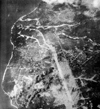|
|
|
|
| Missing In Action (MIA) | Prisoners Of War (POW) | Unexploded Ordnance (UXO) |
| Chronology | Locations | Aircraft | Ships | Submit Info | How You Can Help | Donate |
|
 5th AF c1944  417th BG c1944 |
Location Lat 3° 42' 37S 128° 5' 21E Laha Airfield is located at 33' above sea level at Laha (Raha) on Ambon Island in the Molucca Islands. Also known as "Laha Drome" or "Ambon West". Borders Ambon Bay (Bay of Ambon). To the east is Ambon. Prewar and during the Pacific War part of the Netherlands East Indies (NEI). Today located in Maluku Province (Provinsi Maluku) in Indonesia. Construction Built prewar by the Dutch as one of two airfields on Ambon Island. The second was at Liang Airfield. Laha Airfield had two diverging runways. No. 1 runway oriented 40° and No. 2 runway oriented 0°. Wartime History During late 1941, Allied forces at Laha Airfield included one Dutch bomber, two fighters and Royal Australian Air Force (RAAF) Hudsons from No.13 Squadron. On December 23, 1941 a force of B-17 Flying Fortresses from the 19th Bombardment Group (19th BG) that took off from Batchelor Field landed at Laha Airfield to refuel then took off again to fly a bombing mission against the Japanese forces landing at Lingayen Gulf, that was a 4,600 mile mission. On the night January 6, 1942 seven Japanese flying boats dropped thirty-three bombs on three targets, two Hudson bombers, a Buffalo fighter and workshop facilities at the airfield sustained damaged with three native civilians killed. Allied aircraft withdrew on January 16, 1942 in the face of the impending Japanese assault. Prior to the Japanese landings, Dutch & Australians destroyed naval oil reserves, bomb dumps, hangars and other equipment at Laha, and sought to make the airfield unusable. The airfield was defended by 1,100 Australians, 400 Dutchmen and about 5,000 native troops. On February 1, 1942 Japanese Special Naval Landing Force (SNLF) attack Laha Airfield and furious combat lasted nine hours. On February 2, 1942 in the middle of the morning, the surviving Australian waved a white flag to surrender. After they gave up, the Japanese murdered the 200+ prisoners by beheading. Occupied by the Japanese, they used the airfield for the rest of the war, including as a staging base for Japanese bombing missions against Australia. Japanese and American missions against Laha Airfield January 6, 1942–August 11, 1945 Postwar The No. 1 runway was extended to 6,070' and remained in use as a civilian airport. Today Still in use today as Pattimura Airport. Airport codes: ICAO: WAPP IATA: AMQ. The single runway is oriented 22/04 measures 8,202' x 148' surfaced with asphalt. References The Carnage at Laha, February 1942 via Wayback Machine October 27, 2009 Pattimura Airport official website Contribute
Information Last Updated
|
Map Fallingrain Photo Archive View in Google Earth |
| Discussion Forum | Daily Updates | Reviews | Museums | Interviews & Oral Histories |
|